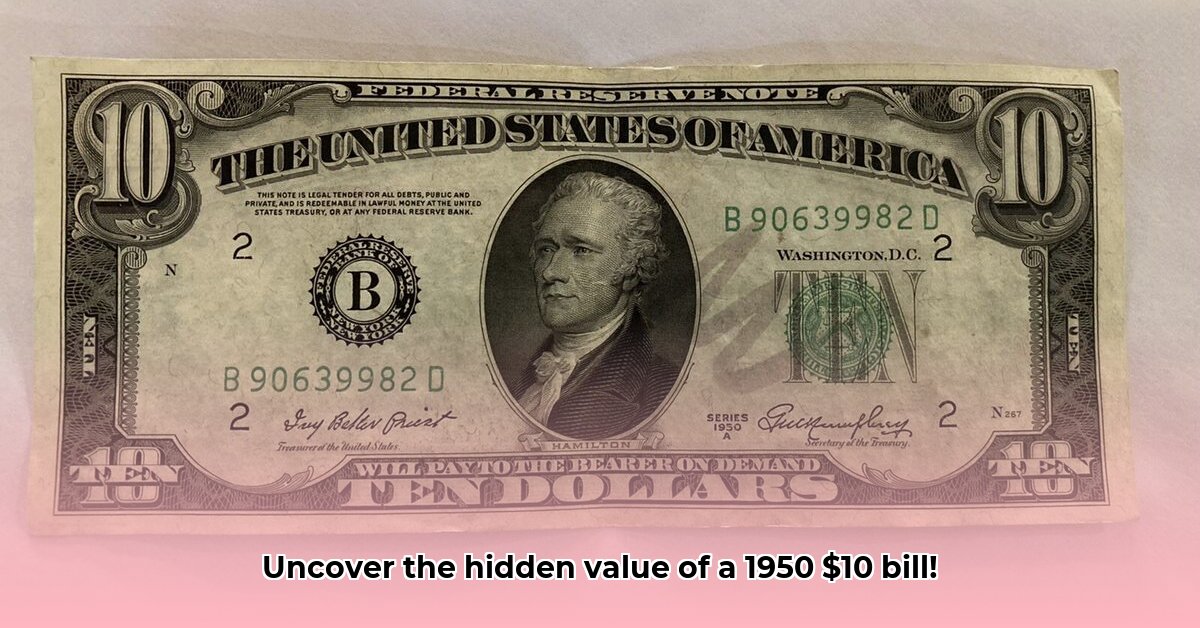
Ever wondered about the hidden value within that old ten-dollar bill? The 1950 $10 bill, Series B, presents a fascinating case study in numismatic appreciation. This comprehensive guide explains what makes these bills valuable and how to assess their worth, whether you're a seasoned collector or a curious novice.
Understanding the Factors Affecting Value
The value of a 1950 Series B $10 bill is determined by several interconnected factors: condition, the presence of a star note designation, serial number characteristics, and the issuing Federal Reserve Bank. Let's explore each:
Condition (Grading)
A bill's condition is paramount. Numismatists (coin and currency collectors) use grading scales, often numerical (e.g., 1-70), to assess a note's state of preservation. Higher grades, such as 65 or 70 (indicating a near-perfect, uncirculated bill), command substantially higher prices. Lower grades reflect wear and tear, diminishing value. Professional grading services, such as PCGS or NGC, provide objective assessments, crucial for accurate valuation and mitigating potential disputes.
Star Notes: A Rarity Boost
"Star Notes" are replacement bills printed to substitute flawed originals. The "star" designation, typically subtly incorporated into the serial number, indicates this special status. This rarity significantly increases a bill's value compared to standard notes.
Serial Numbers: The Collector's Lottery
Certain serial number patterns are highly sought after by collectors. These "fancy" serial numbers can include:
- Repeating digits: (e.g., 11111111)
- Low numbers: (e.g., 00000001)
- Sequential numbers: (e.g., 12345678)
- Mirror numbers: (e.g., a palindrome like 1234321)
The more unique and visually appealing the pattern, the higher the potential value increase.
Federal Reserve Bank Designation: Regional Rarity
Each Federal Reserve Bank has a unique letter code printed on the note. The rarity of the specific bank's code influences value. Some banks issued fewer notes than others, impacting supply and demand.
How to Assess Your 1950 $10 Bill
Determining the value of your bill involves careful, systematic analysis:
Assess the Condition: Meticulously inspect the bill for tears, creases, stains, or other imperfections using good lighting and magnification if needed. Refer to established grading standards for condition assessment.
Identify Star Notes: Carefully examine the serial number for the presence of a star.
Analyze the Serial Number: Note if any "fancy" serial number patterns are present.
Note the Federal Reserve Bank: Locate and identify the Federal Reserve Bank's letter code.
Consult Pricing Resources: Several online resources and specialized numismatic price guides offer market value estimates. Remember that these are averages; your specific bill's condition significantly impacts its final value. Websites such as serialworth.com are a helpful starting point.
Consider Professional Grading: For potentially high-value notes, professional grading is highly recommended. This ensures an objective, verifiable assessment, protecting against undervaluation and potential disputes.
Potential Risks and Mitigation Strategies
Collectible currency investment carries intrinsic risks:
| Risk Factor | Likelihood | Impact | Mitigation |
|---|---|---|---|
| Grading Inconsistency | Medium | High | Utilize professional grading services for objective assessment. |
| Market Volatility | Medium | Medium | Diversify numismatic investments, monitor market trends regularly. |
| Counterfeit Notes | Low | Very High | Verify authenticity through reputable dealers and authentication techniques. |
Conclusion: Turning Knowledge into Value
By understanding the key factors influencing value – condition, star note designation, serial number characteristics, and Federal Reserve Bank code – you can more accurately assess the potential worth of your 1950 Series B $10 bill. Remember that accurate grading and consistent market research are vital for mitigating risks and maximizing returns. Careful evaluation, coupled with professional assessment when needed, allows you to transform a seemingly ordinary bill into a valuable piece of numismatic history.